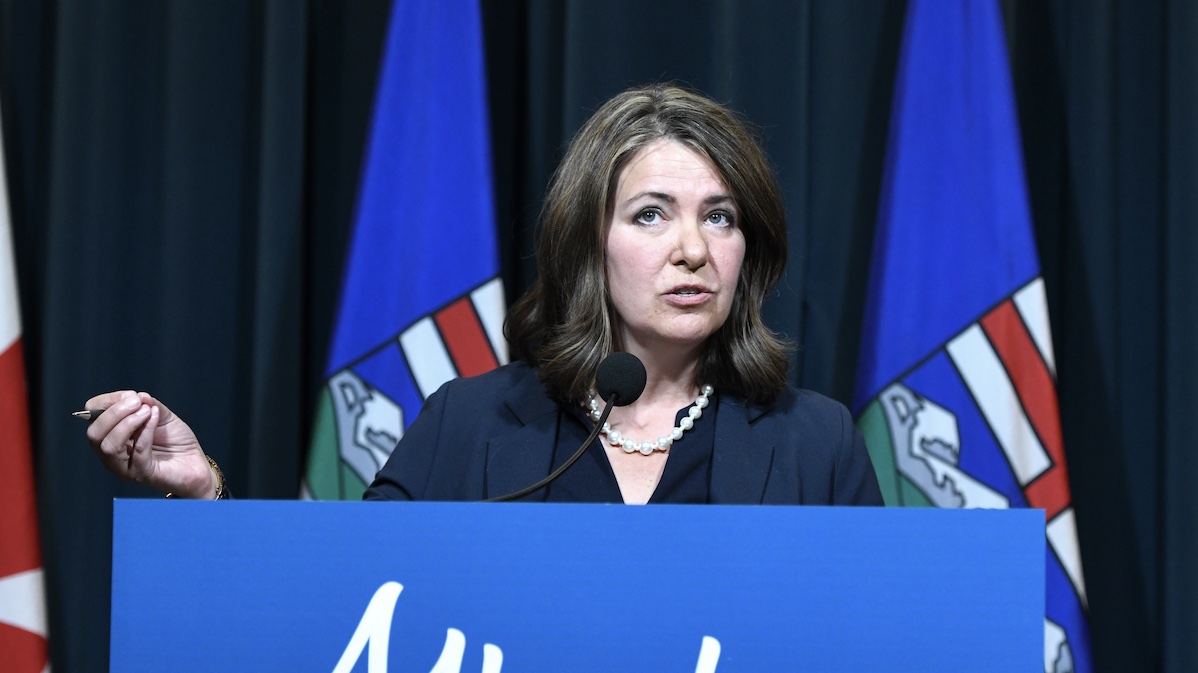What was supposed to be a scripted jeremiad by Alberta Premier Danielle Smith attacking the federal government’s proposed clean-electricity regulations yesterday turned into a verbal sparring match with some feisty reporters over when the government actually decided to freeze the application process for new renewable electricity generation projects.
The Globe and Mail’s Emma Graney and Alberta Today’s Catherine Griwkowsky refused to be intimidated by Smith’s gaslighting during her news conference in Calgary. Graney’s effort in particular to get the premier to answer her questions about when the government decided to impose the moratorium and why it didn’t consult the industry about it deserves a mention in dispatches. It can be found starting at 25:56 in the government’s video of the newser.
It’s not every day I’d recommend that readers sit through the entire 46-minute news conference, including the comedic effort by reporters for a couple of far-right propaganda outfits to pump the premier’s tires while sowing doubt about the independence of the Supreme Court of Canada, but this is one of those times.
When the dust had settled, it was quite clear there’s something suspicious about the premier’s line that she was asked by Alberta’s utilities and electricity regulators to impose the moratorium and therefore had no choice but to immediately impose the seven-month freeze announced by Utilities Minister Nathan Neudorf on Aug. 3.
As Graney put it in her story published yesterday evening, “The letters – both dated July 21, two weeks before Mr. Neudorf announced the pause – show no such request.”
Despite the premier’s claim renewable energy companies should have known the freeze was coming if they’d only listened to the regulators, Ms. Graney wrote, “numerous solar and wind developers with applications in the pipeline told The Globe that the Alberta Utilities Commission had asked for more documents to support their applications mere hours before the government announced the moratorium.”
Also yesterday, University of Alberta energy and environmental economist Andrew Leach laid out the problem with the premier’s timeline in a Twitter thread more bluntly than a reporter for a newspaper that takes itself as seriously as The Globe and Mail would ever be allowed to do.
There’s something fishy about the moratorium timing, Leach began, referencing the premier’s claim it was requested by the Alberta Utilities Commission and the Alberta Electric System Operator. But as the two reporters pointed out, he added, “that’s not what letters say nor do the dates line up.”
The letter from the AUC was issued on July 21, he noted, and requests direction from the government. But contrary to the premier’s claims, it does not ask for a pause.
“Here’s where things get fishy,” Leach continued. The letter from AESO has the same date as the AUC letter, but starts by thanking the government for advising ASEO that it was planning to implement a six-month pause. So, he said, obviously “by that point the government had already decided on a pause.”
Then there is the matter of the electronic signature of AESO President Michael Law on the letter, indicating it was actually signed at 5 p.m. on July 20. So, Leach asked, “before the letter was received by the government from the AUC ‘requesting’ a pause, gov’t had advised AESO of the pause?”
“And now, for the kicker,” Leach concluded. “This tells you that the [Government of Alberta] had made the decision to pause AUC wind and solar approvals for six months two full weeks before they announced it. And yet they managed to consult with nobody connected to the industry, it would seem. Scheduling conflicts?”
In response to other reporters’ questions during the news conference, Smith also returned to her original explanation that the freeze was imposed because of rural concerns about the location of wind and solar electricity generation projects on prime agricultural land, whatever that imprecise phrase means.
“I think the industry should expect that we’re going to make sure that prime agriculture land is going to be protected and that these are going to be sited on marginal lands,” she said, giving the impression the outcome of the policy review has already been determined.
About the best you can say about Smith’s constant positioning and repositioning the reasons for the moratorium is that it’s incoherent. But, as always with this premier, the stories are delivered confidently and sound convincing as they flow from her lips.
The scripted portion of the news conference included no surprises, just the usual belligerent assertions Alberta will never agree to the current federal proposed regulations, will defy them if imposed by law, and that reaching net zero electricity generation by 2035 is impossible. “If it comes down to it, we’re gonna do our own thing,” she vowed.
As for the premier’s repeated statements Alberta could reach net zero by 2050, her government is clearly hoping for the election of a Conservative federal government led by Pierre Poilievre that will scuttle the whole clean electricity plan well before that. That could happen.
In other news, the Servus Centre recreation facility in the Edmonton-area bedroom community of St. Albert was being set up last night as an emergency reception area for evacuees airlifted and bused from Hay River, Fort Smith, and other communities in the Northwest Territories threatened by rampaging forest fires.
Contributor
AB
Reporters and Smith battle over freeze on renewable electricity generation
About the best you can say about Alberta Premier Danielle Smith’s constant positioning and repositioning the reasons for the moratorium is that it’s incoherent.



